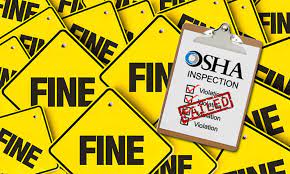Largest and Most Common OSHA Fines for Funeral Homes

Share
Even if you have safety signage up, written safety plans updated, and have conducted training in the past year, you still probably spend more on safety than you think. The following items are some of the most frequent OSHA safety fines for funeral homes:
-
Waste Disposal Fees
-
Fire Extinguishers
-
Exit Markers and Signage
-
Personal Protective Equipment
-
Quick Drench Shower and Emergency Eye Wash Station
-
Training Employees (initial training and annual renewal training)
-
Training Materials
-
Administration (documenting the training and other areas)
-
Hepatitis B Vaccinations
-
Safe Sharps
-
Meeting Electric and Building Codes
Since employers not employees have to bear the cost of occupational injuries, what do these violations actually mean to a funeral home?
Depending on a funeral home’s workers compensation plan and other insurance, these costs may be spread out over several years, but in the end, it is still employers who pay for on-the-job injuries.
Many funeral homes do not recognize injury costs. They see insurance fees go up every year and how quickly medical costs rise, but they do not account for injury costs and the loss of productivity. The National Safety Council tracks injury costs every year. The total cost of work injuries in 2018 was $170.8 billion. This figure includes wage and productivity losses of $52.4 billion, medical expenses of $35.0 billion, and administrative expenses of $57.6 billion.
The following details the "Average Total Cost per Claim by Nature of Injury" from OSHA. The extent to which the employer pays the direct costs depends on the nature of the employer's workers' compensation insurance policy. The employer always pays the indirect costs which amount to about 50% of the “Average Total Cost per Claim by Nature of Injury".

-
Laceration/Puncture/Wound - $45,931
-
Poisoning - Chemical (other than metals) - $57,292
-
Puncture - $58,388
-
Sprain - $64,002
-
Carpal Tunnel - $64,953
-
Strain - $67,248
-
Respiratory Disorders (gases, fumes, chemicals, etc.) - $86,127
-
Cancer - $343,129
-
Multiple Physical Injuries - $164,096
-
Multiple Injuries Including Both Physical and Psychological - $257,623
These injury costs are a significant factor to an employer. We can add two more items to the initial list of compliance costs:
-
Workers Compensation Insurance
-
Productivity Loss (when employee misses work due to an injury)
When you do the math, it is clear that even the slightest injury justifies having a OSHA compliance program with (I) written plans, (II) quality training, and (III) expert support, pays for itself many times over.
With a clear approach to safety, three things are sure to happen:
-
Occupational injuries are reduced
-
Probability of employers being fined are reduced
-
Productivity increases
In addition, federal law mandates that every private employer develop and maintain a written safety program that is complete with all the required items.
-Mark Harrison
CST offers everything a funeral home needs to be in full compliance with OSHA, including:
